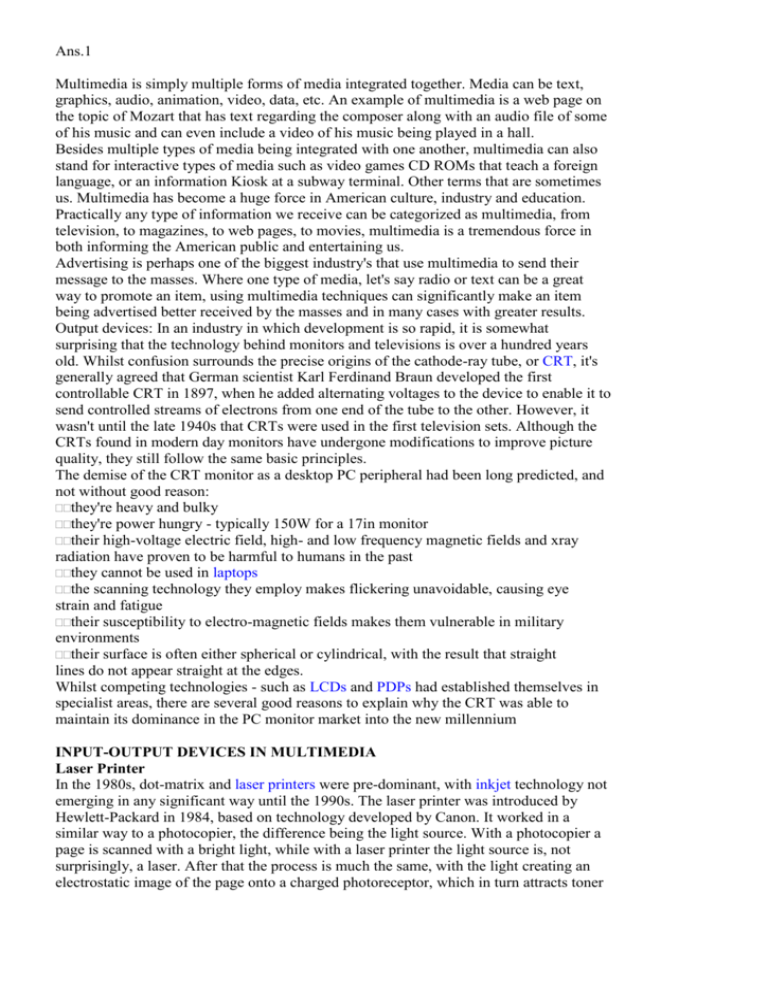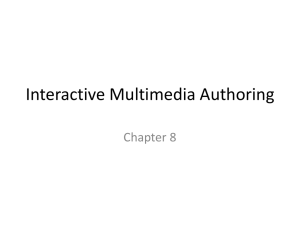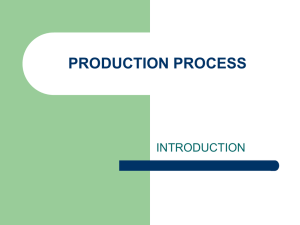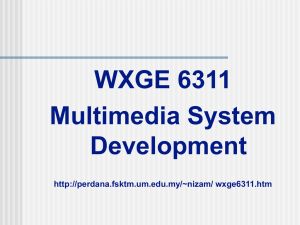Available
advertisement

Ans.1 Multimedia is simply multiple forms of media integrated together. Media can be text, graphics, audio, animation, video, data, etc. An example of multimedia is a web page on the topic of Mozart that has text regarding the composer along with an audio file of some of his music and can even include a video of his music being played in a hall. Besides multiple types of media being integrated with one another, multimedia can also stand for interactive types of media such as video games CD ROMs that teach a foreign language, or an information Kiosk at a subway terminal. Other terms that are sometimes us. Multimedia has become a huge force in American culture, industry and education. Practically any type of information we receive can be categorized as multimedia, from television, to magazines, to web pages, to movies, multimedia is a tremendous force in both informing the American public and entertaining us. Advertising is perhaps one of the biggest industry's that use multimedia to send their message to the masses. Where one type of media, let's say radio or text can be a great way to promote an item, using multimedia techniques can significantly make an item being advertised better received by the masses and in many cases with greater results. Output devices: In an industry in which development is so rapid, it is somewhat surprising that the technology behind monitors and televisions is over a hundred years old. Whilst confusion surrounds the precise origins of the cathode-ray tube, or CRT, it's generally agreed that German scientist Karl Ferdinand Braun developed the first controllable CRT in 1897, when he added alternating voltages to the device to enable it to send controlled streams of electrons from one end of the tube to the other. However, it wasn't until the late 1940s that CRTs were used in the first television sets. Although the CRTs found in modern day monitors have undergone modifications to improve picture quality, they still follow the same basic principles. The demise of the CRT monitor as a desktop PC peripheral had been long predicted, and not without good reason: they're heavy and bulky they're power hungry - typically 150W for a 17in monitor their high-voltage electric field, high- and low frequency magnetic fields and xray radiation have proven to be harmful to humans in the past they cannot be used in laptops the scanning technology they employ makes flickering unavoidable, causing eye strain and fatigue their susceptibility to electro-magnetic fields makes them vulnerable in military environments their surface is often either spherical or cylindrical, with the result that straight lines do not appear straight at the edges. Whilst competing technologies - such as LCDs and PDPs had established themselves in specialist areas, there are several good reasons to explain why the CRT was able to maintain its dominance in the PC monitor market into the new millennium INPUT-OUTPUT DEVICES IN MULTIMEDIA Laser Printer In the 1980s, dot-matrix and laser printers were pre-dominant, with inkjet technology not emerging in any significant way until the 1990s. The laser printer was introduced by Hewlett-Packard in 1984, based on technology developed by Canon. It worked in a similar way to a photocopier, the difference being the light source. With a photocopier a page is scanned with a bright light, while with a laser printer the light source is, not surprisingly, a laser. After that the process is much the same, with the light creating an electrostatic image of the page onto a charged photoreceptor, which in turn attracts toner in the shape of an electrostatic charge. Panel Display The lighter, space saving flat panel monitors offer clear advantages over CRT monitors. Digital video Another mini-revolution within the PC world, home video editing has opened an unprecedented world of creativity to business and home users into the 21st Century. Keyboard A computer keyboard is effectively an array of switches, each of which sends the PC a unique signal when pressed. Two types of switch are commonly used: mechanical and rubber membrane. Mechanical switches are simply spring-loaded "push to make" types, so when pressed down they complete the circuit and then break it again when released. These are the type used in clicky keyboards with plenty of tactile feedback. Trackball A trackball is a pointing device consisting of a ball housed in a socket containing sensors to detect rotation of the ball about two axes - like a mouse lying on its back. The cursor is moved about the screen by a user rolling the ball with their thumb, fingers, or the palm of their hand. There are usually one to three buttons next to the ball, which are in the same way as mouse buttons. Joysticks A joystick is a PC peripheral or general control device consisting of a handheld stick that pivots about one end and transmits its angle in two or three dimensions to a computer. Most joysticks are two-dimensional, having two axes of movement (similar to a mouse), but three-dimensional joysticks do exist. A joystick is generally configured so that moving the stick left or right signals movement along the X axis, and moving it forward (up) or back (down) signals movement along the Y axis. In joysticks that are configured for three-dimensional movement, twisting the stick left (counter-clockwise) or right (clockwise) signals movement along the Z axis. These three axis - X Y and Z - are, in relation to an aircraft, roll, pitch, and yaw, respectively. Joysticks are often used to control games, and usually have one or more push-buttons whose state can also be read by the computer. Touchsceen A touchscreen is an intuitive computer input device that works by simply touching the display screen, either by a finger, or with a stylus, rather than typing on a keyboard or pointing with a mouse. Computers with touchscreens have a smaller footprint, and can be mounted in smaller spaces; they have fewer movable parts, and can be sealed. Touchscreens may be built in, or added on. Add-on touchscreens are external frames with a clear see-through touchscreen which mount onto the monitor bezel and have a controller built into their frame. Built-in touchscreens are internal, heavy-duty touchscreens mounted directly onto the CRT tube. Ans2 a) Basic multimedia communication technology tends to cover a range of multimedia devices, such as sound cards and graphic cards that allow users to create visual presentations that output sound and /or images. Multimedia generally means the combination of two or more continuous media. The two media are normally audio and video, sound plus moving pictures. For example the digital camera may be used externally to the PC, and allows the user to record images. When connecting the camera to the computer, using a cord, images will be formatted and printed. Various computers have sound cards stored within them, this allows output of sound from speakers through the use of CD’s, and other formats that may have music attached to it. Sound cards allow individuals to listen to music played or stored on their computer. Whereas Communications technology refers to the transmission of data from one computer to another from one device to another. Computer systems refer to an entire working computer. All computer systems consist of various components they include the case of the computer the power supply and many other components. The Motherboard in a computer that manages the communication and function of all information. The Processor is another term for (CPU) Control Panel Unit. A microprocessor chip, the CPU is the brain of the computer; it uses mathematical functions to perform calculations. Random Access Memory Also referred to as the (RAM) holds the application programs and data in current use, it may also be occupied by software as operating systems and interpreters. Computer systems also include a Bus, the Hard Drive which has encoding data on the hard drive there has been two approaches firstly being the MFM, and the next being RLL. Other components include Peripherals, Monitor, Keyboard, and various Pointed Devices including Joysticks. Computer Networks Computer networks are able to achieve communication between a couple of computers. Networks are split into three parts. Local Area Network A Local Area Network is also known as a (LAN) they are privately owned networks within a single building or campus. LANs are distinguished from other kinds of networks by three characteristics (1) their size, (2) their transmission technology, and (3) their topology. Hub This is a LAN device that broadcasts the information it receives to all attached devices and segments of the network. Bridge This limits the collision domain, can extend network distances, and can also filter packets on their MAC addresses and ease congestion. Router These have two functions firstly to determine the best path to a destination and to share path information the “route” with other routes. A router can also connect networks using different media and architectures, which enable them to determine the best path for a packet to reach another network. They can also filter broadcasts. Network Interface Card The Network Interface Card allows devices to connect to the network. They provide connections for any type of networking media, including wireless media. Internal hardware installed within computer amongst other devices that allow them to communicate on a network. Metropolitan Area Network This is constructed of LANs that are interconnected across a city or metropolitan area. An example of a MAN is the cable television network available in many cities. MANs require routers, telephone and ATM switches, and microwave antennas. They produce single points of connection between each LAN. ATM Switch A network device which is used by telecommunications companies like the local telephone company to support multiple connections on an ATM network. Wide Area Network This is also referred to as a (WAN) Two or more LANs or MANs, which are interconnected using slow-speed connections over telephone lines. Modem A modem is a device used by telecommunications companies like the local telephone company to support multiple connections on an ATM network. Ans 2 b). Techniques of animations 1. Procedural Animation Procedures are used that define movement over time. These might be procedures that use the laws of physics (Physically - based modeling) or animator generated methods. An example is a motion that is the result of some other action (this is called a "secondary action"), for example throwing a ball which hits another object and causes the second object to move. 2. Representational Animation This technique allows an object to change its shape during the animation. There are three subcategories to this. The first is the animation of articulated objects, i.e., complex objects composed of connected rigid segments. The second is soft object animation used for deforming and animating the deformation of objects, e.g. skin over a body or facial muscles. The third is morphing which is the changing of one shape into another quite different shape. This can be done in two or three dimensions. 3. Stochastic Animation This uses stochastic processes to control groups of objects, such as in particle systems. Examples are fireworks, fire, water falls, etc. 4. Behavioral Animation Objects or "actors" are given rules about how they react to their environment. Examples are schools of fish or flocks of birds where each individual behaves according to a set of rules defined by the animator. Ans.3 MULTIMEDIA AUTHORING TOOL REFER BLOCK-1 CH-3 – TOPIC 3.0 Authoring systems are menu……………………………………….involved in CBT Features of Multimedia Authoring Software Refer topic-3.3 block-1 full content Difference between flash and authorware Flash has vector graphics and powerful animation abilities. It is an OOP tool (object oriented), giving finite control of many elements It is developed as a web-delivery tool first and foremost, and as such suffers many restrictions (sandboxed in the browser) that prevent access to the user's system and to many system features and functions. Flash is used by millions of people around the world The Flash web player is reportedly installed on 98% of all PCs and Macs. It has payers for other systems like PocketPC, some phones, Linux, Sun .. but only Windows and Mac have the most recent player. First and foremost Flash was a web-based animation tool, but it has evolved into a powerful multimedia system. It still has significant handicaps when compared to tools that are not restricted by the browser. Authorware has poor vector graphics, but can import most types of images, movies and animations. Authorware is not fully Oop, but does now have the option of using JavaScript code which adds an Oop layer to some parts of Authorware. Authorware was developed as a computer-based tool for delivering training. As it evolved it became a tool for delivering CD-based and then web-based training too. Authorware has the ability to access the entire computer system, including system dlls, the registry, ActiveX controls ... if packaged as exe this access is there by default. If web packaged, the Authorware piece has to be actively 'trusted' to gain such access. NT, Win2000 and XP systems limit such access to that available via the current user privileges. Authorware is used by thousands of people about the world. The Authorware web player is usually not preinstalled on user's machines, and this can be problematic for web delivery, but the problems are not insurmountable. Authorware is a PC-based application but it also has a Mac player. There is an unofficial Linux-based project that makes it possible to run web-packaged Authorware files. Authorware does not run on portable devices. ANS-4 REFER TO THE WEBSITE LINK BELOW & CREATE SIMILAR SLIDES(10-15) WITH THE SAME CONTENTS IN POWERPOINT http://www.authorstream.com/Presentation/Urban-41395-Better-Baby-Care-Caring-Infants-Toddlers-BabiesDevelopment-First-Years-Life-Young-Child-Grows-Faster-car-Education-ppt-powerpoint/








